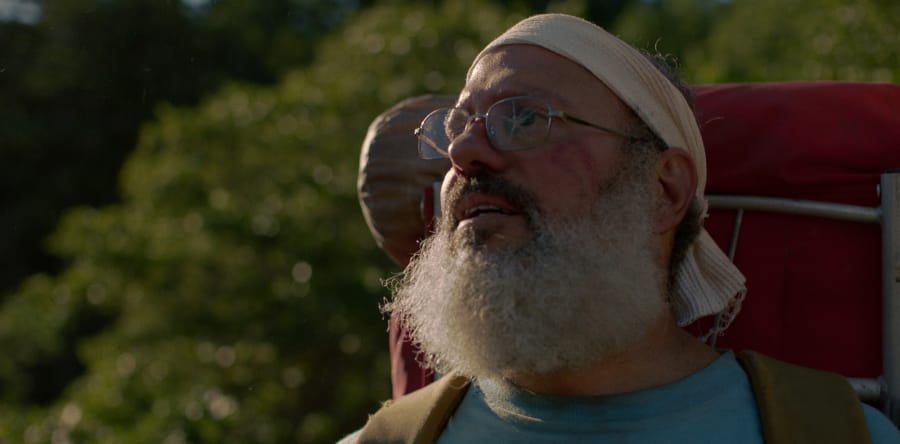He sets out searching for rare butterfly species in the remotest corner of the Gifford Pinchot National Forest, but widowed naturalist Robert Michael Pyle winds up catching much more than that — including glimpses of Sasquatch and of his own healing heart.
Pyle is a real scientist and author who lives in Grays River, northwest of Longview. The version of Pyle who anchors the new film “The Dark Divide,” which you can stream at home starting Friday via Vancouver’s Kiggins Theatre, has been optimized for best cinematic effect, both dramatic and comedic. Take note, TV sitcom fans: Pyle the serious and soulful lepidopterist is portrayed in “The Dark Divide” by David Cross, noted for his role as the pathetically silly wannabe actor Tobias Funke in “Arrested Development.”
If there’s any hint of Tobias in this film, it’s Pyle’s painful awkwardness as his epic trek gets underway. For a butterfly scientist, this Pyle seems surprisingly green when it comes to exploring greenery. His colleagues and his ailing wife have to pressure him into leaving the lab and hitting the trail, and a central theme of the film becomes Pyle versus nature as he contends with thunderous downpours, terrifying cliffs, slick river crossings, dark caverns and wildlife that could eat him for lunch. Not to mention hostile loggers and, perhaps worst of all, a troupe of toxically cheerful, humiliatingly competent Girl Scouts.
All of those episodes were based on things that really happened to Pyle, he said during an interview, but they’re revved up for this film. The real Pyle was an experienced outdoorsman when he embarked upon a six-week, 120-mile hike from Randle to the Columbia River Gorge in 1995, he said.
Pyle doesn’t mind being portrayed in the film as “a nerd and a wimp going into the woods,” he said, because that gives his character room to learn and grow, which is what must happen in any strong narrative.
Pyle said he was stunned when prizewinning filmmaker and Oregon native Tom Putnam contacted him to option his nonfiction book, “Where Bigfoot Walks: Crossing the Dark Divide,” and even more stunned a few years later when the film actually went into production, shooting on location in the wild and roadless area.
“I read (“Where Bigfoot Walks”) and thought it was absolutely amazing … and completely impossible to make into a film,” Putnam said in the film’s press materials. “People would just stare at me when I pitched it to them. It’s a period piece about a butterfly expert on a hike, with very little dialog and a tone that’s a mix of Jack London, Henry David Thoreau and H.P. Lovecraft.”
To fashion drama out of that, Putnam decided to mix in other episodes from Pyle’s life and build a sort of hero’s-journey narrative. The biggest change was making the death of Pyle’s wife the motivation for his solo journey across the Dark Divide, a rugged wilderness area. Pyle’s wife, Thea, did die of cancer but that was many years later, he said.
“I was not on a grief trip at the time, but that would come,” Pyle said. Overall, he was fine with the way Putnam rearranged real events into a narrative that felt true enough to Pyle’s life and experiences, he said.
“My criterion was, the script had to respect Thea and me and butterflies and Bigfoot,” Pyle said. “When I read the script I was very moved. The way Thea was portrayed, I thought it was extraordinary.”
Small footprint for Bigfoot
Pyle’s grant-funded mission in 1995 actually was to search for evidence of Sasquatch, not rare butterflies — as indicated by the title of his resulting book, “Where Bigfoot Walks.”
Filmmaker Putnam decided that any movie focused on Bigfoot would get sidelined by producers and shrugged off by audiences.
“It would get designated a ‘Bigfoot movie’ and it would be a blip and disappear,” Pyle said.
So Putnam decided to make butterflies, Pyle’s actual life’s work, into his movie character’s quest. Questions and suggestions about Sasquatch remain murky around the edges of the film just as the mystery of Sasquatch still does, Pyle pointed out.
Pyle remains a skeptical scientist, he said. Although he repeatedly discovered impossibly gigantic footprints in the Dark Divide region, he remains unsure about the existence of Sasquatch. What’s more important, he said, is that the unsolved mystery itself keeps people delving into nature and striving to protect it.
“One goal I have for the film is for people to open their minds about the world,” he said. “The book was overtly a plea to save the Dark Divide. It’s the biggest unprotected wildland in Washington. Now, the movie has the potential to reach a lot of people, a lot more than the book did.”
“I very much hope this movie will be a big shot in the arm in terms of making the Dark Divide a federal wilderness area,” he said.
Given the coronavirus pandemic, Pyle added, the film’s themes of grief, loss and perseverance have gained extra meaning that its makers didn’t see coming.
“A lot of people are in mourning now. A lot of people have lost a lot,” he said. “People are grieving and I hope, without being soppy or sentimental, the movie can show people how they can find a sense of redemption in the wild.”
Scott Hewitt: 360-735-4525, scott.hewitt@columbian.com




